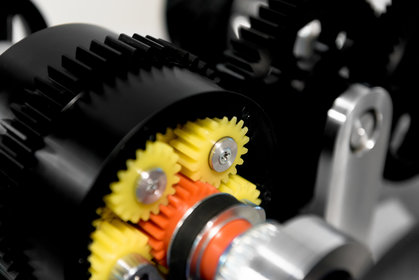
22/03/2017
“Smart” materials: tomorrow’s cars will be impact-proof and equipped with plastic engines.
Dino Collazzo
Special alloys, compounds, shape-memory polymers and metamaterials. The automotive industry continues on its quest to create more efficient vehicles. Exhaust pipes capable of recovering energy from heat, self-repairing tires and chassis able to switch from rigid to flexible in case of accidents. These are some of the possible applications of new and groundbreaking materials still in the testing phase.
A car able to absorb impacts, with a plastic engine to reduce weight and built with materials capable of recovering the energy dissipated through heat. These are some of the possible applications of special alloys, compounds, shape-memory polymers and metamaterials, which could one day be used in producing “smart” cars. Therefore, even before fully connected and self-driving vehicles hit the roads, researches are already going beyond that, imagining models with chassis capable of turning from rigid to flexible in case of accidents, self-repairing tires and ultra-capacitors for electric cars that use carbon nanotubes and are able to instantaneously charge a battery producing maximum power in a very short time.
We are speaking about prototypes, researches and studies still underway, with practical applications that may encompass various industrial sectors, but whose growth potential is currently restricted by high production costs making large-scale production economically not feasible. Nevertheless, for some time now, things have been changing rapidly. So much so that several automotive enterprises - mostly hi-tech companies, multinationals and component manufacturers - have begun to intensify their investments on developing metamaterials, special plastics and shape-memory polymers. According to various financial analysts, this is a growing market which, only in the field of metamaterials, is bound to grow at a compound annual growth rate of about 19.8% in the next decade, enough to reach approximately 3.11 billion dollars by 2025 worldwide. Many of these discoveries are made in universities or specialized laboratories. A case study published some time ago (on nature.com magazine) by a few Michigan University scholars revolved around a metamaterial (artificially created materials) able to move from a rigid to a flexible form thanks to a network of small uprights held together by some connecting hinges (all this at a nanometer scale). As traction is applied to the structure, the surface characteristics of the material change from rigid to flexible. The forces are transferred to the hinges and the structure remains intact. Another example, also published on nature.com, is a study on a "thermal metamaterial" built by a team of scientists from Purdue University (USA), Hamburg (Germany), Alberta (Canada) and the German Helmholtz-Zentrum Geesthacht research center. Taking advantage of its peculiarities, researchers have found that it is possible to produce more efficient thermo-photovoltaic devices able to generate electricity from thermal radiation. A discovery that could be applied, in addition to the production of industrial pipes used in factories and power plants, also to engines and exhaust systems (Video). The heat produced by the combustion phase is transformed into energy which could feed several vehicle components.
And it doesn’t end there. As manufacturers aim to make cars increasingly lighter, thus reducing also fuel consumption and emissions, some are going so far as imagining engines made of plastic. So far, car makers have relied on materials such as high-strength steel and aluminum, but in the future 20% of the weight of the cylinder block could be reduced with plastic reinforced by glass or carbon fibers. The technical challenge in this case is perfecting the materials so as to withstand high temperatures and vibrations without breaking. A car, though, is not limited to only what is hidden under the hood, but also its body, tires, lights, glass and optional. All elements destined to change form and substance thanks to “smarter materials", the knowledge of which will make a difference in terms of business, especially as workshops will have to deal with them in a not too distant future.
We are speaking about prototypes, researches and studies still underway, with practical applications that may encompass various industrial sectors, but whose growth potential is currently restricted by high production costs making large-scale production economically not feasible. Nevertheless, for some time now, things have been changing rapidly. So much so that several automotive enterprises - mostly hi-tech companies, multinationals and component manufacturers - have begun to intensify their investments on developing metamaterials, special plastics and shape-memory polymers. According to various financial analysts, this is a growing market which, only in the field of metamaterials, is bound to grow at a compound annual growth rate of about 19.8% in the next decade, enough to reach approximately 3.11 billion dollars by 2025 worldwide. Many of these discoveries are made in universities or specialized laboratories. A case study published some time ago (on nature.com magazine) by a few Michigan University scholars revolved around a metamaterial (artificially created materials) able to move from a rigid to a flexible form thanks to a network of small uprights held together by some connecting hinges (all this at a nanometer scale). As traction is applied to the structure, the surface characteristics of the material change from rigid to flexible. The forces are transferred to the hinges and the structure remains intact. Another example, also published on nature.com, is a study on a "thermal metamaterial" built by a team of scientists from Purdue University (USA), Hamburg (Germany), Alberta (Canada) and the German Helmholtz-Zentrum Geesthacht research center. Taking advantage of its peculiarities, researchers have found that it is possible to produce more efficient thermo-photovoltaic devices able to generate electricity from thermal radiation. A discovery that could be applied, in addition to the production of industrial pipes used in factories and power plants, also to engines and exhaust systems (Video). The heat produced by the combustion phase is transformed into energy which could feed several vehicle components.
And it doesn’t end there. As manufacturers aim to make cars increasingly lighter, thus reducing also fuel consumption and emissions, some are going so far as imagining engines made of plastic. So far, car makers have relied on materials such as high-strength steel and aluminum, but in the future 20% of the weight of the cylinder block could be reduced with plastic reinforced by glass or carbon fibers. The technical challenge in this case is perfecting the materials so as to withstand high temperatures and vibrations without breaking. A car, though, is not limited to only what is hidden under the hood, but also its body, tires, lights, glass and optional. All elements destined to change form and substance thanks to “smarter materials", the knowledge of which will make a difference in terms of business, especially as workshops will have to deal with them in a not too distant future.






